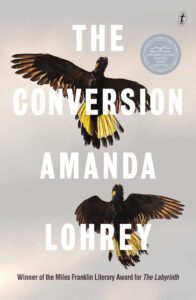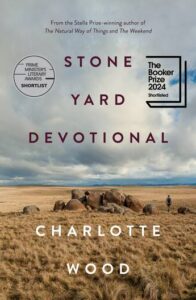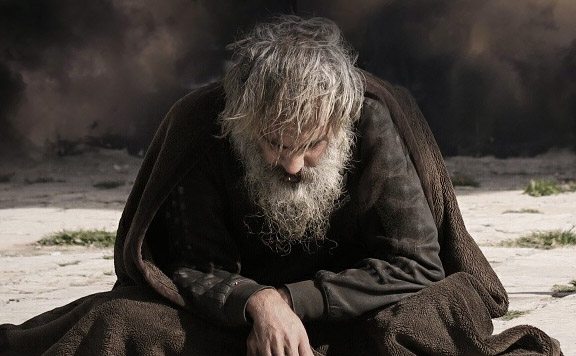I have been delighted and fascinated to come across multiple novels published in the last year or so, written by non-Christian authors and published by mainstream secular presses, whose central theme is some aspect of Christian religious practice. These novels are fundamentally post-Christian rather than anti-Christian. They are not interested in exposing church hypocrisy or critiquing Christian beliefs; rather they sympathetically explore the power of Christian practice. This is not to say that they contain no scepticism, simply that they are not primarily polemical.
Architecture: The Conversion by Amanda Lohrey
The Conversion (Text Publishing, 2023) has much in common with The Labyrinth—the book that immediately preceded it, for which Lohrey won the 2021 Miles Franklin Literary Award. Both focus on older middle-aged women moving to regional Australia in seasons of great personal loss; both explore Christian architecture and its ability to convey a sense of transcendence.
2021 Miles Franklin Literary Award. Both focus on older middle-aged women moving to regional Australia in seasons of great personal loss; both explore Christian architecture and its ability to convey a sense of transcendence.
Those aware of Charles Taylor’s work will discover the familiar theme of the disenchantment of modernity here. The main character confronts the challenges of converting an old church building into a home:
with the removal of the font, she sees that the unity of the whole has been tilted out of balance. The church had been a body, and now it has lost a limb. The buyer of a church must impose their own dream, which means they can only live in it if all trace of its original purpose is camouflaged or destroyed: ‘As much as possible, vertical space (heaven) must be rendered horizontal (earth).’ Somewhere she had read this, somewhere in Nick’s notes …
In the afternoon she drives to a nearby nursery and buys an enormous terracotta pot planted with a tall Kentia palm and directs the delivery man to stand it where the font had been. It would do for now. When Neville rings she will tell him that the site for redemption from original sin has been replaced by Home Beautiful … A church cannot be made other, cannot be undivided. She sees now that as soon as possible everything must go, and that includes the windows. (147–8)
Liturgy: Stone Yard Devotional by Charlotte Wood
Stone Yard Devotional (Allen & Unwin, 2023) has been short and longlisted for many major awards including the Booker Prize. A burned-out environmentalist finds herself joining a religious community of Roman Catholic nuns in her regional hometown. While unconvinced by its metaphysical claims and baffled by their monotonous practices, the protagonist cannot deny their esoteric attraction:
environmentalist finds herself joining a religious community of Roman Catholic nuns in her regional hometown. While unconvinced by its metaphysical claims and baffled by their monotonous practices, the protagonist cannot deny their esoteric attraction:
The sun is lifting and it streams into the church each time the big wooden door opens. The nuns enter quietly. The one with the walking frame arrives first. She might play the organ, though from my seat near the back of the guest pews I can’t see around the corner. Another lights the candle—one near their door, another by the lectern and two on the floor, at the foot of the big crucifix.
The singing is transporting, especially when they harmonise. One nun leads a psalm and the others do a repeated chorus. Lauds, like Vespers, goes for half an hour.
After this comes the Eucharist (which might also be called Terce?) at nine o’clock.
During Lauds I found I was thinking, But how do they get anything done? All these interruptions day in, day out, having to drop what you’re doing and toddle into church every couple of hours. Then I realised: it’s not an interruption to the work; it is work. This is the doing. (14)
Revivalism: On a Bright Hillside in Paradise by Annette Higgs
On a Bright Hillside in Paradise (Vintage Books, 2023) was winner of the 2022 Penguin Literary Prize. It is a vivid portrayal of late-nineteenth-century Brethren revivalism in the North-West of Tasmania, based on real events. Higgs portrays the electric power of great preaching:

Shuffling noises filled the barn, the soft sounds of a hundred people breathing. The sharp odours of perspiration and anticipation joined the animal smells of the barn. The mesmerising voice spoke on, words of peace and rest and blessing and promise. The preacher strode up and down, turning now and then with a wide gesture of his arms to encompass everyone.
Echo Hatton, fourteen years old and thin as a stick, sat on a disintegrating hay bale wedged between her grannie Eliza and her mother Susannah … Echo stared at the other women, the other mothers and daughters and grandmothers. They all bent like sunflowers towards the front of the barn, attracted by the speaker with the waving arms.
… How long all this went on, no-one afterwards could really remember. At times it seemed brief and events flashed past; at other times it seemed the night stretched on and on. When the people of the district looked back, this evening always seemed like an island in an ocean of days. It seemed to mark a before and an after. (3–4,7)
For more on On a Bright Hillside see my earlier review.
Picking Over the Rubbish Tip
All three novels are focussed on Christian religious practice much more than Christ himself (On a Bright Hillside is the most explicit on the gospel, for obvious reasons). But what they do dwell upon is how elements of Christian spirituality bring greater meaning to life. They bring to light how many post-Christian Australians, whether atheist, agnostic, or of no fixed religious affiliation, still resonate with the idea of a deeper spiritual reality. More, they are also drawn to places and practices that can spiritually ground them.
Some quarters of Western culture are beginning to wonder whether treasures were lost when Christianity was thrown out, are beginning to pick over the rubbish tip to retrieve them, in warm, perplexed curiosity, at the very least. This surely provides new opportunities for gospel conversation and invitation.














